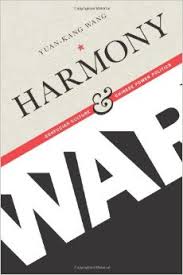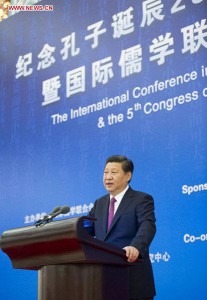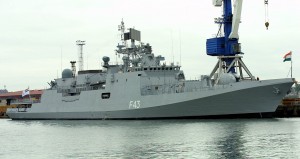Couldn’t make it to CIMSEC’s Forum for Authors and Readers? Well you missed out, and we missed you, but the good news is you can check out most of the presentations online now .
Can China Rise Peacefully? What Does History Suggest?
John J. Mearsheimer concludes his book, The Tragedy of Great Power Politics, with the chapter “Can China Rise Peacefully?” This is certainly on the minds of many, as over the the past few years the size of China’s economy has overtaken that of the U.S. While China’s economy grows, so too has her aggressive stance on her territorial claims in the South China Sea, Scarborough Shoal and the Senkaku Islands. Coupled with her rapid double digit increases in military spending, one would be hard pressed not to conclude that China is quickly rising to “Great Power” status, if not there already.
At the same time, China’s leadership has gone out of its way to promote its policy of “peaceful development.” It has embarked on a program of “neighborhood diplomacy” emphasizing “friendship and partnership” and “good neighborliness.” It has even enshrined this policy of peaceful development and eschewed hegemonic intentions in the Chinese Communist Party doctrine.
 China asserts that unlike Western powers, it can rise peacefully due to its unique Confucian cultural tradition. In 2014, China celebrated the 2,565th birthday of Confucius (551-479 BC), and President Xi Jinping provided the keynote address marking the occasion. In it, he sought to emphasize that China’s Confucian heritage, integrated within Communist doctrine (naturally) would promote social harmony at home and peaceful understanding with its neighbors and the world. Martin Jacques, author of When China Rules the World, suggests as much when he describes China as a “civilization state” rather than a “nation state.“
China asserts that unlike Western powers, it can rise peacefully due to its unique Confucian cultural tradition. In 2014, China celebrated the 2,565th birthday of Confucius (551-479 BC), and President Xi Jinping provided the keynote address marking the occasion. In it, he sought to emphasize that China’s Confucian heritage, integrated within Communist doctrine (naturally) would promote social harmony at home and peaceful understanding with its neighbors and the world. Martin Jacques, author of When China Rules the World, suggests as much when he describes China as a “civilization state” rather than a “nation state.“
So what are we to make of this? Will China’s “Confucian exceptionalism” exempt her from the traditional historical patterns of conflict when rising powers bump up against status quo powers like the United States? Yuan-kang Wang, assistant professor at Western Michigan University addresses that question in his book, Harmony and War: Confucian Culture and Chinese Power Politics. In it, he asks, “To what extent does culture influence a state’s use of military force against external security threats?” This is the central concern to those in the world outside of China, as history tends to suggest that when a rapidly rising power threatens an established power, competition almost inevitably leads to conflict – the dreadful Thucydides’s Trap. (There is a good argument that the trap may already have been sprung.)
 Returning to China and its Confucian tradition, what does history suggest? The premise of Dr. Wang’s book is to address head on whether “cultural theories [which] argue that ideational factors … can transform the harmful effects of [state system anarchy] and have an independent effect of state behavior.” Therefore, China’s strategic behavior in the past should largely reflect and be explained by the cultural traditional of “Confucian pacifism.”
Returning to China and its Confucian tradition, what does history suggest? The premise of Dr. Wang’s book is to address head on whether “cultural theories [which] argue that ideational factors … can transform the harmful effects of [state system anarchy] and have an independent effect of state behavior.” Therefore, China’s strategic behavior in the past should largely reflect and be explained by the cultural traditional of “Confucian pacifism.”
Confucian pacifism has four key features: a culture of antimilitarism, defensive grand strategy, the theory of just war and limited war aims. Antimilitarism suggests that China has a historic bias toward civil virtue over martial virtue as shown by its state promotion of Confucian ideology. Its tradition of nonviolence led it to favor a defensive grand strategy over aggressive expansion, relying on “cultural attraction” or the “benevolent way” as opposed to the Western tradition of the “hegemonic way.”
Even Confucius understood that military preparedness was important to state survival. However, he argued for “righteous war” (similar to Western just war), and suggested that force be used “only when defensive options are exhausted.” Confucius also maintained that force is justified “when the ruler of another state is morally depraved,” similar to the current theory of “humanitarian intervention.” Yet this should be punitive in nature, and not for the purpose of annexing territory or expansion. War aims should be limited to the restoration of the status quo ante, never for the total destruction of the enemy.
So does Chinese history bear out its Confucian pacifism? Dr. Wang looks at two periods in China’s history, the Northern and Southern Song Dynasty (960-1179 AD) and the Ming Dynasty (1368 – 1644 AD) and finds that “Confucian culture did not constrain the leaders’ decision to use force; in making such decision, leaders have been mainly motivated by their assessment of the balance of power between China and its adversary.” This largely aligns with the expectations of structural realism theory as opposed to cultural realism theory.
Dr. Wang argues that three themes emerge in Chinese history. First, “China’s decision makers frequently probed for weakness in the country’s adversaries and took advantage of it when found.” Imperial China was never reluctant to use force, nor did it use force only as a last resort. China is not as pacifist as some scholars (and its political leadership) would suggest.
Second, its use of coercive force largely correlated with its relative power position. When strong, Imperial China adopted “offensive-oriented” strategies. When it considered itself weaker, they sought to maintain a defensive posture and be more accommodating “while embarking on domestic reforms aimed at strengthening its military forces and improving its economy.” Indeed, court documents and transcripts indicate that officials would most often refer to Sun Tzu’s strategy of subduing the enemy without fighting only when in a position of weakness rather than as a matter of universal policy.
Finally, war aims were not limited to “defensive border protection” or “restoration of the status quo.” This was evident in both policy debates within the Imperial Court and in actual behavior. Indeed when China had to adopt a more defensive posture, this was less a cultural preference and more a result of insufficient offensive capabilities.
 Take China’s construction of The Great Wall. This is often pointed to as an example of both Confucian pacifism and China’s historically defensive nature. However, Dr. Wang’s review of court transcripts on the decision making process and historical context that led to its construction paint a different picture. Construction of the today’s recognizable wall began in 1474 AD, during the Ming Dynasty, amid constant conflict with the Mongols. Debate amongst the Ming court showed a preference for launching an attack on the Mongols to recover lost territory and bring them to heel. However, they were constrained not by a cultural predilection for defensive strategy but rather a lack of offensive capabilities. Indeed, the Confucian traditionalists “lamented that a country as great as China should come under the mercy of the culturally inferior nomads” – themes that would be echoed by Chinese leadership today when recalling China’s “Century of Humiliation.” In short, an assessment of military weakness drove the Ming to build The Great Wall, not Confucian tradition.
Take China’s construction of The Great Wall. This is often pointed to as an example of both Confucian pacifism and China’s historically defensive nature. However, Dr. Wang’s review of court transcripts on the decision making process and historical context that led to its construction paint a different picture. Construction of the today’s recognizable wall began in 1474 AD, during the Ming Dynasty, amid constant conflict with the Mongols. Debate amongst the Ming court showed a preference for launching an attack on the Mongols to recover lost territory and bring them to heel. However, they were constrained not by a cultural predilection for defensive strategy but rather a lack of offensive capabilities. Indeed, the Confucian traditionalists “lamented that a country as great as China should come under the mercy of the culturally inferior nomads” – themes that would be echoed by Chinese leadership today when recalling China’s “Century of Humiliation.” In short, an assessment of military weakness drove the Ming to build The Great Wall, not Confucian tradition.

Dr. Wang’s historical study challenges the popular narrative of China’s historic cultural pacifism. This has implications for future relations between China, her neighbors and the United States, as China’s leaders use this Confucian tradition as a legitimizing mechanism of its peaceful development and growing military power. He ends his study by suggesting that “based on theory and history, China will gradually shift to an offensive grand strategy when it has accumulated sufficient power.”
Of course, one should not be fatalistic or succumb to historical determinism. Conflict need not be inevitable. However, while history does not repeat itself, it does rhyme. American policy makers (and our friends and allies around the world) would do well to consult Dr. Wang’s book.
About the Author:
LT Robert “Jake” Bebber USN is an Information Warfare officer assigned to U.S. Cyber Command and is a contributor to the CIMSEC NextWar Blog. His articles have appeared in Orbis, Proceedings, Small Wars Journal and elsewhere. Jake holds a PhD in Public Policy from the University of Central Florida. He is supported by his wife, Dana and their son, Vincent. The views expressed here are his own and do not reflect those of the U.S. Department of Defense, the U.S. Navy or U.S. Cyber Command. He welcomes your comments at jbebber@gmail.com.
The Rapid Growth of the Algerian Navy
The Algerian Navy has been on a buying frenzy in recent years, amassing a significant maritime force. In September 2014, representing the culmination of a longer term procurement project, Italy’s Orizzonte Sistemi Navali (OSN) delivered Algeria’s new flagship, an 8,800-tonne amphibious assault ship called the Kalaat Beni-Abbes. But newer projects than OSN’s are currently underway. A shipyard in Saint Petersburg, Russia is building two new Kilo-class diesel-electric submarines for Algeria, while two MEKO A200-class frigates, three F-22P Zulfiquar-class frigates, and two Tigr-class corvettes are being produced for service in the Algerian National Navy at shipyards ranging from Kiel to Karachi.
 This vastly outpaces the procurement projects of Algeria’s neighbours. In 1993, Algeria and Tunisia successfully resolved their maritime boundary dispute and have since launched several joint energy exploration projects. Tunisia’s 2010-2011 revolution and concerns in Algeria that the uprising might bring an Islamist regime to power created some uncertainty, but the bilateral relationship remains on the whole quite positive. Although the nearby Strait of Gibraltar has seen some heightened tension between British and Spanish maritime forces, Algeria is not a party to any of these confrontations. In this context, the aggressive expansion of the Algerian National Navy must be rather confusing.
This vastly outpaces the procurement projects of Algeria’s neighbours. In 1993, Algeria and Tunisia successfully resolved their maritime boundary dispute and have since launched several joint energy exploration projects. Tunisia’s 2010-2011 revolution and concerns in Algeria that the uprising might bring an Islamist regime to power created some uncertainty, but the bilateral relationship remains on the whole quite positive. Although the nearby Strait of Gibraltar has seen some heightened tension between British and Spanish maritime forces, Algeria is not a party to any of these confrontations. In this context, the aggressive expansion of the Algerian National Navy must be rather confusing.
However, it is possible that Algeria is preparing for a significant counter-piracy role. NATO’s Operation Unified Protector devastated the Libyan Navy. Currently, that country’s maritime forces consist of one Koni-class frigate, one Natya-class minesweeper, and two Polnocny-C landing ships. NATO air strikes in May 2011 totally destroyed Libya’s naval bases at Sirte, Khoms, and Tripoli. While the maritime forces loyal to the Libyan government are small in number and poorly equipped, rebels continue to hold a few ports in Libya’s east, though most were freed in a series of offensives during the summer and autumn of 2014. Earlier, in March 2014, one rebel militia succeeded in loading an oil tanker in defiance of the Libyan authorities, prompting the ouster of Prime Minister Ali Zeidan.
If the Libyan authorities are struggling to secure their own ports, it is conceivable that rebel groups in the country’s eastern regions could engage in piracy in future years. Such a situation would jeopardize Algeria’s economic growth as it seeks to become a major energy exporter to Europe and Asia. In March 2014, Algerian officials announced plans to increase oil and natural gas production by 13% to 220 million metric tonnes of oil equivalent in two years. The resulting increase in tanker traffic on North Africa’s coast would present plenty of prime targets for Libyan pirates.
Yet it remains unclear whether it is indeed a counter-piracy role that is envisioned for the Algerian National Navy. Algeria is not officially cooperating with Operation Active Endeavour, which is NATO’s counter-terrorism and counter-proliferation force in the Mediterranean Sea, though five ships assigned to the NATO Mine Counter-Measures Group did make a port visit to Algiers in September 2014 prior to joining Active Endeavour. In order to avoid conflict from emerging between Algeria and Libya over the security of international shipping routes, it may be necessary for NATO officials to aggressively pursue a closer relationship with both countries.
Through the Mediterranean Dialogue, NATO established an Individual Cooperation Program (ICP) with Israel in 2006, which allows for Israeli participation in Operation Active Endeavour and other mutually beneficial initiatives. Other ICPs were completed with Egypt in 2007 and Jordan in 2009. Securing ICPs with Algeria and Libya, however, will be an uphill battle; Algeria has participated in NATO’s Mediterranean Dialogue since 2000 but Libya has yet to even respond to a 2012 invitation to join. Nonetheless, it is still an effort worth attempting as it may help to avoid much hardship and conflict in the future. For now, Algeria seems to be bracing for impact.
Paul Pryce is a Research Analyst at the Atlantic Council of Canada. His research interests are diverse and include maritime security, NATO affairs, and African regional integration.
This article can be found in its original form at Atlantic Council of Canada.
Sea Control 69 – South Pacific
 Heard of Guadalcanal? Check. But what about the rest of the South Pacific? Between 1999 and 2012, Australia committed troops to multiple peacekeeping and stabilisation missions in Timor Leste, the Solomon Islands and Bougainville. In this podcast, get to know the neighbours–Australia’s neighbours. Listen to Natalie Sambhi interview ASPI analyst and resident silver fox, Dr Karl Claxton, on why the South Pacific matters, its political and economic development, and its key players (Papua New Guinea, Fiji, Tonga and New Caledonia). They discuss Australia’s and New Zealand’s respective roles in supporting maritime security and why the US should take more notice of the South Pacific as part of the rebalance.
Heard of Guadalcanal? Check. But what about the rest of the South Pacific? Between 1999 and 2012, Australia committed troops to multiple peacekeeping and stabilisation missions in Timor Leste, the Solomon Islands and Bougainville. In this podcast, get to know the neighbours–Australia’s neighbours. Listen to Natalie Sambhi interview ASPI analyst and resident silver fox, Dr Karl Claxton, on why the South Pacific matters, its political and economic development, and its key players (Papua New Guinea, Fiji, Tonga and New Caledonia). They discuss Australia’s and New Zealand’s respective roles in supporting maritime security and why the US should take more notice of the South Pacific as part of the rebalance.
DOWNLOAD: Sea Control 69 – South Pacific
Remember, subscribe on iTunes or Stitcher Stream Radio. Leave a comment and rate five stars!
Produced by: Matthew Hipple
Hosted by: Natalie Sambhi
Audio Editing By: Dmitry F.




